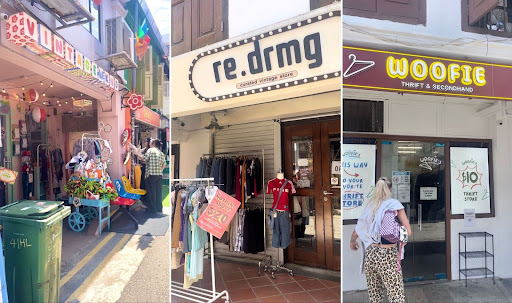Global warming is a pressing reality, and youths everywhere are well aware of it. Meanwhile, the perceived need for youths to be fashionable remains – be it hair or outfit, youths want to look good. So, how can these two go hand in hand? The answer is simple: thrift shopping. Thrift stores are shops selling second-hand clothing items and trinkets. Thrift shopping, also known as thrifting, has been gaining popularity in Singapore, especially among youths looking for unique fashion finds and more sustainable ways to shop.
If you are looking to go thrifting in Singapore, Haji Lane is the place to visit. Lined with thrift stores left and right, the area is always crowded, filled with teenagers and young adults. Although youths are the target market, the pricing of their goods is far from youth-friendly.

A growing number of consumers are voicing concerns that the prices are getting too high, making it hard to differentiate them from typical retail stores one can find at malls. Many thrift stores in Singapore started with a mission to provide affordable, second-hand clothing while promoting sustainability. However, as these stores gain footfall, the rising costs of rental spaces (not to mention Haji Lane being a hot tourist spot), increased demand, and the trendiness of thrifting have led to the noticeable price hikes.

When we checked these stores out, we were surprised by the price range – an old vintage-esque pair of pants was priced at $60 and a reworked shirt was around $45! (Usually, clothing would range around $15 to $60, depending on what you bought, and where you bought them.) Additionally, overpriced hair clips and accessories, which could be easily found on online shopping platforms like Shopee and Taobao, were sold as well.
As we ventured deeper into the thrifting scene, we found that people are willing to pay extra not just for a more eco-friendly alternative, but also for the novelty of owning a unique piece from a thrift store.
Ultimately, whether these prices are deemed expensive is a personal judgement that varies from shopper to shopper. It all comes down to individual purchasing power and budget. For some, the thrill of finding one-of-a-kind items may justify the higher price tags. Your own financial comfort and shopping priorities will shape how you perceive the value of what thrift stores have to offer.
On the other hand, for some, this defeats the purpose of thrifting. Students and young adults, who make up a significant portion of the thrifting community, find themselves unable to afford these higher prices. The concept of thrift shopping, which was meant to be a cost-effective and sustainable alternative, now seems less accessible.
To understand the target market’s perspective, we reached out to youths in Haji Lane to gather their thoughts on the pricing of thrift store merchandise and their overall experiences as thrifters in Singapore. Watch our street interview to find out more!
@theurbanwire We all know that the most affordable way to change out our wardrobe is shopping at Singapore’s thrifting hotspot, Haji Lane…but is it still? 🤔 Thrifting in Singapore is gradually losing its appeal as prices continue to soar. With nearly identical products available online at comparatively lower prices, many youths, the main audience of thrifting, can no longer keep up with the inflation. Join The UrbanWire as we hear what youths have to say about thrifting and its prices 🛍️ #theurbanwire #thrifting #hajilane #singapore #fypsingapore
♬ original sound – theurbanwire – theurbanwire
